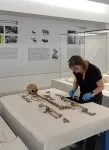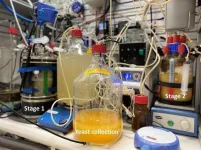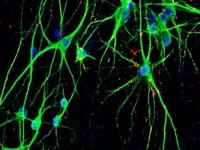Quantum researchers cause controlled ‘wobble’ in the nucleus of a single atom
2024-09-12
(Press-News.org)
Researchers from Delft University of Technology in The Netherlands have been able to initiate a controlled movement in the very heart of an atom. They caused the atomic nucleus to interact with one of the electrons in the outermost shells of the atom. This electron could be manipulated and read out through the needle of a scanning tunneling microscope. The research, published in Nature Communications today, offers prospects for storing quantum information inside the nucleus, where it is safe from external disturbances.
For weeks on end, the researchers studied a single titanium atom. “A Ti-47 atom, to be precise,” says research leader Sander Otte. “It has one neutron less than the naturally abundant Ti-48, which makes the nucleus slightly magnetic.” This magnetism, the ‘spin’ in quantum language, can be seen as a sort of compass needle that can point in various directions. The orientation of the spin at a given time constitutes a piece of quantum information.
Precisely tuned
The nucleus of an atom floats inside a – comparatively – giant void far away from the orbiting electrons, oblivious of its environment. But there is one exception: due to the extremely weak ‘hyperfine interaction’, the nuclear spin can be influenced by the spin of one of the electrons. “Easier said than done,” says Lukas Veldman, who recently defended his PhD dissertation on the research with honours. “The hyperfine interaction is so weak that it is effective only in a very small, precisely tuned magnetic field.”
Voltage pulse
Once all experimental conditions were met, the researchers used a voltage pulse to push the electron spin out of equilibrium, after which both spins wobbled together for a fraction of a microsecond. “Exactly how Schrödinger predicted,” says Veldman. Alongside the experiments he performed calculations that reproduced the observed fluctuations surprisingly well. The strong agreement between observations and predictions demonstrates that no quantum information is lost during the interaction between electron and nucleus.
Storing quantum information
The efficient shielding from the environment makes the nuclear spin a viable candidate for holding quantum information. The current research may bring that application one step closer. But that is not what primarily drives the researchers. Otte: “This experiment gives humans influence on the state of matter on an unimaginably small scale. To me, that alone makes it worth the effort.”
END
ELSE PRESS RELEASES FROM THIS DATE:
2024-09-12
Cardiovascular diseases are the leading cause of mortality in Western Europe, accounting for 1/3 of deaths in 2019. Diet is thought to be responsible for around 30% of such deaths. Nutrition-related prevention policies therefore constitute a major public health challenge for these diseases.
In an article to be published on 11 September 2024 in Lancet Regional Health - Europe, researchers from the Nutritional Epidemiology Research Team (CRESS-EREN), with members from Inserm, Inrae, Cnam, Université Sorbonne Paris Nord and Université Paris ...
2024-09-12
Landmark new research shows Ice Age teens from 25,000 years ago went through similar puberty stages as modern-day adolescents. In a study published today in the Journal of Human Evolution of the timing of puberty in Pleistocene teens, researchers are addressing a knowledge gap about how early humans grew up.
Found in the bones of 13 ancient humans between 10 and 20 years old is evidence of puberty stages. Co-led by University of Victoria (UVic) paleoanthropologist April Nowell, researchers found specific markers in the bones that allowed them to assess the progress of adolescence.
“By analyzing specific areas of the skeleton, we inferred things like menstruation ...
2024-09-12
Inflammatory bowel disease (IBD), encompassing Crohn’s disease (CD) and ulcerative colitis (UC), is a chronic inflammatory disorder of the gastrointestinal (GI) tract that significantly impacts the quality of life of patients. With an incidence of approximately one in 200 individuals in developed countries and a rising trend in developing and newly industrialized nations, IBD poses a substantial burden on healthcare systems. Due to the nonspecific nature of its clinical manifestations and the lack of a gold-standard diagnostic test, managing IBD effectively remains a challenge. Therefore, reliable and widely available biomarkers ...
2024-09-12
Researchers in Germany can harvest protein and vitamin B9 from microbes by feeding them nothing much more than hydrogen, oxygen, and CO2. The technology, published September 12 in the Cell Press journal Trends in Biotechnology, runs on renewable energy to produce a sustainable, micronutrient-enriched protein alternative that may one day make it to our plates.
“This is a fermentation process similar to how you make beer, but instead of giving the microbes sugar, we gave them gas and acetate,” says corresponding author Largus Angenent of the University of Tübingen, Germany. “We knew that yeast could produce vitamin B9 on their own with sugar, however, we didn’t ...
2024-09-12
Neurodevelopmental and psychiatric disorders (NPD) including schizophrenia, bipolar disorder, autism, and depression are detrimental to individuals, their families and society as a whole, and in many cases still lack effective treatments. It’s becoming more and more clear that genetic mutations in certain genes can increase the likelihood of developing NPD, and several hundreds of those “risk genes” have been identified to date, but their role related to NPD remains a mystery. “Very little is known about the basic function of most of these genes, and what we do know ...
2024-09-12
About The Study: This case report describes a woman who presented with bilateral blurry vision a few days after dyeing her hair with hair dye containing aromatic amines.
Corresponding Author: To contact the corresponding author, Nicolas Chirpaz, MD, email nicolas.chirpaz@chu-lyon.fr.
To access the embargoed study: Visit our For The Media website at this link https://media.jamanetwork.com/
(doi:10.1001/jamaophthalmol.2024.3453)
Editor’s Note: Please see the article for additional information, including other authors, author contributions and affiliations, conflict of interest and financial ...
2024-09-12
About The Study: This study found that certain social determinants of health affected monitoring for diabetic retinopathy similarly for Black and white patients with diabetes while others affected them differently. Patients living in rural communities, Black patients with preexisting diabetic retinopathy, and Hispanic white patients were not receiving eye care in accordance with clinical practice guidelines, which may contribute to worse outcomes.
Corresponding Author: To contact the corresponding author, Dustin D. French, PhD, email dustin.french@northwestern.edu.
To access the embargoed ...
2024-09-12
About The Study: This single-center cohort study identified substantial overall survival disparity and differing frequencies of driver gene variations by race and ethnicity. Socioeconomic status had the largest contribution but accounted for less than one-third of the disparity, with substantial contribution from tumor molecular features. Further study of the associations of genetic ancestry and the molecular pathogenesis of colorectal cancer with chemotherapy response is needed.
Corresponding ...
2024-09-12
City of Hope and Biopharmaceutical Research Company announce first patient has received BRC-001, a first-in-class cannabinoid therapeutic, in a clinical trial investigating supportive care in breast cancer
Researchers will evaluate whether the cannabinoid therapeutic candidate can address joint pain resulting from cancer treatment using aromatase inhibitors
This side effect has caused many breast cancer patients to discontinue treatment
LOS ANGELES and MONTEREY, Calif. — City of Hope®, one of the largest cancer research and treatment organizations in the United States, and Biopharmaceutical Research ...
2024-09-12
Connecticut, U.S.A -- Some chemicals create environmental problems; others, fortunately, can help clean them up.
Chemists from Yale University and their colleagues have developed an electrochemical catalyst and membrane that offers an efficient and sustainable way to treat water contaminated with trichloroethylene (TCE), a common and persistent environmental pollutant. Their findings highlight the potential for advanced electrochemical treatments in environmental remediation and open the door for further innovations in the field.
Their results were published in Carbon Future ...
LAST 30 PRESS RELEASES:
[Press-News.org] Quantum researchers cause controlled ‘wobble’ in the nucleus of a single atom






